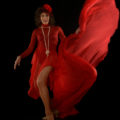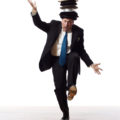Tutto Mondo’s interview with Bob Boross is now available in English. Starting from Charles Goddertz we are publishing or reissuing some of our interviews for our international readers.
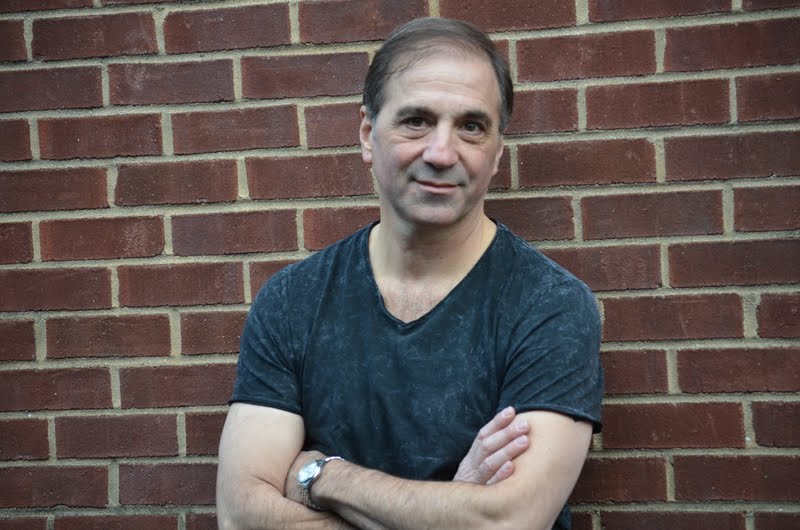
1. Photo by courtesy of Bob Boross.
Bob Boross is known internationally for his artistic excellence in jazz, tap, and musical theatre dance. His career began as a musical theatre performer in productions of West Side Story, Godspell, Zorba, Funny Girl, The Boyfriends, and The Pirates of Penzance (Pirate King). He made his Broadway debut in 1981, for the revival of Can-Can, with choreographies Roland Petit.
As a choregrapher, among his works in the USA, we can mention Annie Get Your Gun, Guys and Dolls, Victor/Victoria, and Empy Sky…The Rising.
On the international scene, Bob Boross has collaborated with different institutions in many parts of the world, for example, the Just Jazz Dance Company in Finland, the Millennium Dance 2000 in London, La Bella Vita Arts in Italy, and the University of Dance and Circus in Stockholm.
Bob‘s choreography has been commissioned in three major American cities: New York, Los Angeles e Washington DC, working with dance companies, festivals, and events like Jazz Roots Dance company or the Velocity DC Dance Festival.
In August 2016 Bob Boross was one of nine invited jazz dance professors to headline the National Dance Educator’s Organization Roots of Jazz Dance conference held in Rhode Island.
Bob Boross is also known for his writings about jazz dance that were published in dance magazines and for his two books, Image of Perfection: The Freestyle Dance of Matt Mattox e Comments on Jazz Dance 1996-2014.
Bob holds the M.A. in Individualized Study (Jazz Dance) from the Gallatin School of New York University. He has teached in many universities, including the Illinois State University, the Western Kentucky University and the University of California, Irvine. Bob Boross is currently an Adjunct Professor of Jazz Dance at Marymount Manhattan College in New York City.
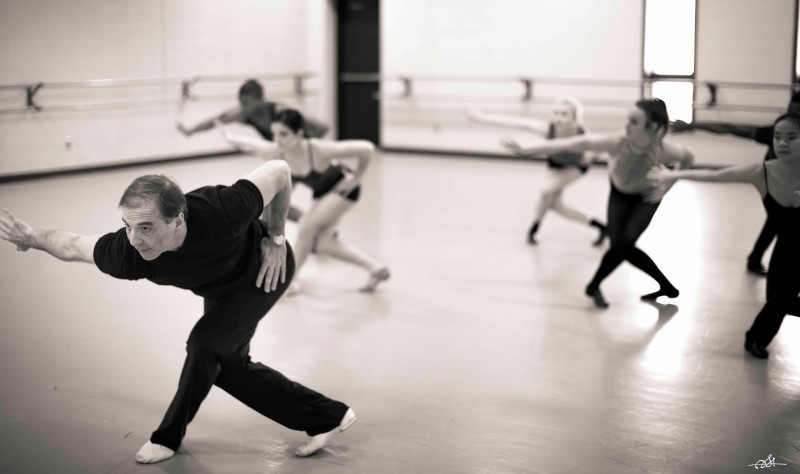
2. Bob while teaching Mattox’s technique, photo by courtesy of Bob Boross, N Link Photography.
What means Jazz dance for you and what do you love about it?
«Jazz and jazz dance is a feeling of joy and liberation. I was first drawn to jazz and tap dance as it made me just feel good to do it. I’ve pursued it ever since».
Which was your favourite shows to dance into, during your career, and why?
«I first began in musical theatre at age 19, and my first show was West Side Story. Once I did that, I was hooked. I had a short performing career, but a much longer career as a teacher and a choreographer. I enjoy choreographing musicals due to the unique choreographic challenge that each show brings. I also enjoy choreographing for concert dance as that is when I have my fullest creative expression – it’s the most full representation of my expression and ideas».
What is Jazz dance today? In which direction Jazz dance is going nowadays?
«Jazz dance has been on the “back burner” for a few decades, due to the changes in musical tastes since the 1940s and also the changes in society/technology. Jazz rhythmic structures are not often found in today’s contemporary music. So younger people do not normally have within their bodies the movement structures that relate to jazz. In the last 15 years, jazz has been pushed into musical theatre classes. Contemporary and hip hop dance have become alternatives that may speak more to younger people than jazz.
But – there is now a newer conversation going on about the true history and nature of jazz dancing, which will be sparked by the upcoming jazz dance documentary film Uprooted – The Journey of Jazz Dance. It premieres in the US on July 19, 2020 at the Dance on Camera Film Festival at Lincoln Center, and later in the year throughout Europe. I believe that in the near term future, more attention will be given to jazz dance due to this renewed examination of the roots of jazz dance, and it’s intrinsic value».
 3. Big Men On Mulberry Street. Photo by courtesy of Bob Boross.
3. Big Men On Mulberry Street. Photo by courtesy of Bob Boross.
How much is important for young dancers to learn about the legacy of the masters of Jazz?
«If someone is serious about jazz dance, it is critical to study its history and its evolution. To understand the movement characteristics that came from African culture and also European culture. To know the dynamic movement concepts of jazz dance, and then to use those concepts as building blocks for an artistic expression that is related to today’s way of thinking».
Bob Boross, you were lucky enough to work and study with Matt Mattox, any memories about him you want to share with us?
«Matt was a stellar dancer first as a ballet dancer, and then in his work in jazz dance related forms. His technique and choreographic inventions drew deeply from his immense personal dance ability, creating a supreme challenge to those who studied with him.
Achieving such a height of ability only comes from an exceptional work ethic, and Matt demanded that level of devotion from himself and all of those around him. This made him a remarkable person to learn from, but also a difficult one as he expected perfection.
In fact, the title of my New York University thesis, Image of Perfection: The Freestyle Dance of Matt Mattox came from a description of him given in a French publication in the 1980s. There are many stories that I could tell about Matt, but I’ll just leave you with that one thought – he truly was an “image of perfection”».
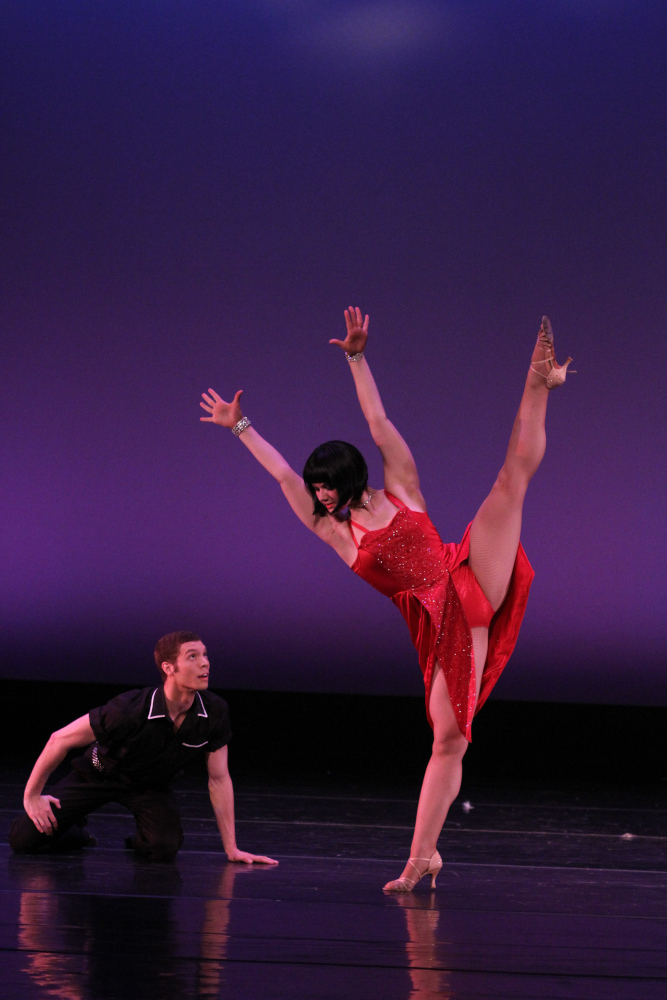 4. Love Fell Out With Me. Photo by courtesy of Bob Boross, photographer Rick Foster.
4. Love Fell Out With Me. Photo by courtesy of Bob Boross, photographer Rick Foster.
What is Mattox’s freestyle and why do you think is important that dancers learn this method?
«This is a very deep question. Although he is normally associated with “jazz dance,” Matt preferred to call his work “freestyle.” This term first came from the ballet choreographer and teacher Eugene Loring, who also choreographed Hollywood films and who directed the American School of Dance in Los Angeles starting in the mid-1940s. Loring experimented with a dance class that mixed aspects of ballet, jazz, modern, and other forms of dance. Loring called this class “freestyle” to denote that it was not one singular technique, but a melange of the best aspects of all dance techniques.
Matt danced in many Loring films and also was a student at the American School of Dance. When Matt eventually went on his own way about 1955 for his career and moved to New York, he created a dance training class that grew out of Loring’s freestyle philosophy. Matt’s strong ballet technique was mixed with his knowledge of the Jack Cole movement style, and also other genres like tap and Flamenco, and his class reflects aspects of all of those techniques.
Matt as a creative artist wanted to express himself in any way that he felt, not being relegated to only ballet or only jazz dance. So the freestyle philosophy refers also to the personal creativity of a human being and not just to his class. If you are familiar with Matt’s class teaching, you’ll recognize that he made his class choreographies to a wide range of musical choices, not only to jazz music. Some of his combinations took shape in more strongly balletic ideas, or modern ideas, or jazzy ideas – all depending on how he felt that day in class.
Matt felt that “jazz dance” was the original vernacular dances like the lindy, Charleston, Susie Q, etc. His work, with its strong influence of ballet and other dance forms, could only then be described as “freestyle”».
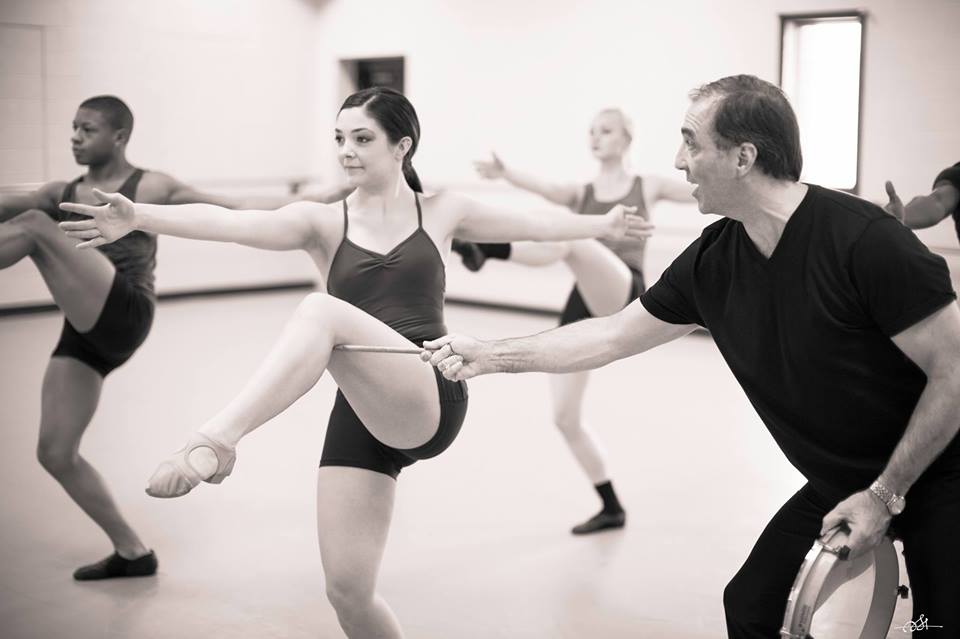 5. Bob while teaching in one of his classes.. Photo by courtesy of Bob Boross and N Link Photography.
5. Bob while teaching in one of his classes.. Photo by courtesy of Bob Boross and N Link Photography.
You had the opportunity to work in Europe and also teach in Italy. What do you think about our country and our dancers? Any suggestion for Italian dancers who want to approach Jazz dance?
«I have taught in Italy for summer dance workshops, but the majority of students have been Americans who are visiting and taking a summer course. But I would offer the same advice that I would give to dancers from any country where I have taught.
Jazz dance is based on a musicality and a feel in the body that is unique to good jazz music. The swing feeling, the loose relaxed joints, and the instinctive reflex aspect of how to move.
These characteristics may not be inherent in the dancers of non-American countries, due to cultural and musical differences. So, I would advise that dancers listen to good jazz music, and find how the rhythmic structure of the swing and syncopated music can then be mirrored or internalized in the body, as a response to the music.
When the body is loose and swinging just like the music is loose and swinging, then the dancer will be dancing jazz».
Bob Boross, you also teach Tap dancing and more than once you have mentioned Paul Draper and his influence on your tap style with his peculiar fusion of ballet and tap. What are the most important style differences between Draper and other tap dancers?
«Of course Paul Draper was unique in mixing the lighter feel ballet steps with the more grounded, heavier stance that is normally associated with traditional tap dancing. Draper’s upper body was often high and lifted, and he executed tap steps using a balletic port de bras. His arms were not relaxed and by his sides. He also struck the floor with his taps in a very light fashion, not heavy and chunky.
For taps, he used a very small tap on the front of his shoe and then he would file it down to make it as thin a possible. For his heel tap, he used an old-fashioned men’s “half moon” tap that shoemakers would attach to men’s shoes to reduce the wear on the heels of the shoe.
Draper also took ballet steps and then added or adapted them with tap steps. For instance, he would perform the balletic assemble – but instead of landing on both balls of the feet and then rolling down to the heels Draper would land in a tap “cramp roll” of ball-ball-heel-heel, making the four sounds of the cramp roll as he landed and completed his assemble.
Draper was a solo tap dance artist during the 1940s and 1950s, giving solo concerts across the US and internationally. He tapped to classical music more often than he tapped to jazz music».
Empty Sky…The Rising was an ambitious project, using Bruce Springsteen’s music to recount the catastrophic events that happened on September 11th, 2001. How did you come up with this idea and how did jazz dance and freestyle impact you in the creation process?
«Again, a very long story here. I will not expound that long, and just say that when I first heard Bruce Springsteen’s 2002 CD The Rising, I immediately visualized all of the stories and characters in terms of dance choreography. It was like a movie playing in my head. First I wrote out scenarios for nine songs from the CD, one each day for nine days.
It took more than a year to have the chance and resources to work on such a big project. From the first initial workshop in November 2003, I made an “MTV” style video and sent it to Springsteen’s management with a request for rights to use the music for a full public performance. It took 18 months for that decision to come, giving me permission. From there it was another ten months to create the final production and to add two more songs to the performance.
It had its premiere Sept. 7-11, 2005 at the Two River Theatre in Red Bank, NJ. It was a highly emotional and evocative performance, with the physical and visual telling of the stories matched to the soundtrack of Springsteen’s music. By contractual rights I am not permitted to post the video in full on Youtube, so there are only some clips on my website and Youtube channel. There are many great images shot by the renowned dance photographer Eduardo Patino».
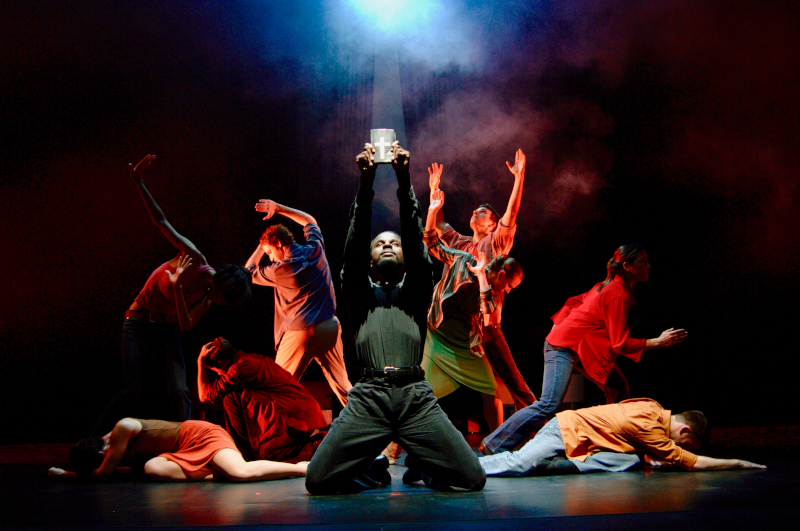
6. Empty sky… the Rising. Photo by courtesy of Bob Boross, photographer Eduardo Patino.
Let’s talk more about your work as a choreographer, do you have a specific choreographing process?
«I work with good music that has a strong rhythmic structure that moves and engages me. Many music styles do not reach me, so I don’t react and I don’t use them. I also look for a structure of orchestration that allows for a flow of story or feelings. For instance, my piece Mercy Street to the song by Peter Gabriel and as played by Herbie Hancock is a great example. The contrasting high and deep melodic and rhythmic lines, and the long linear development of the improvisations, all give me ideas for feelings, emotions, and storytelling.
As mentioned with Empty Sky…The Rising, I often just hear the music, and then let my mind wander to create a scenario for which the music would be excellent “background” music. That way, the music and the movement are integrated completely.
I also listen for emotional qualities inherent in the music, that will give me structural and movement ideas. A good example here is Road to Resilience which was later re-titled On The Brink. I had been aware of the racial discord in Ferguson, Missouri in 2015 due to the shooting of a black teenager by a white policemen, and the tension/anguish of the event. I then heard a Nicholas Payton version of Solea from the Sketches of Spain album by Miles Davis. The tension in the music, and the structural build in the music and then the eventual residual fade away allowed me to construct a choreography that reflected the tensions and anger of people in the situation of that shooting».
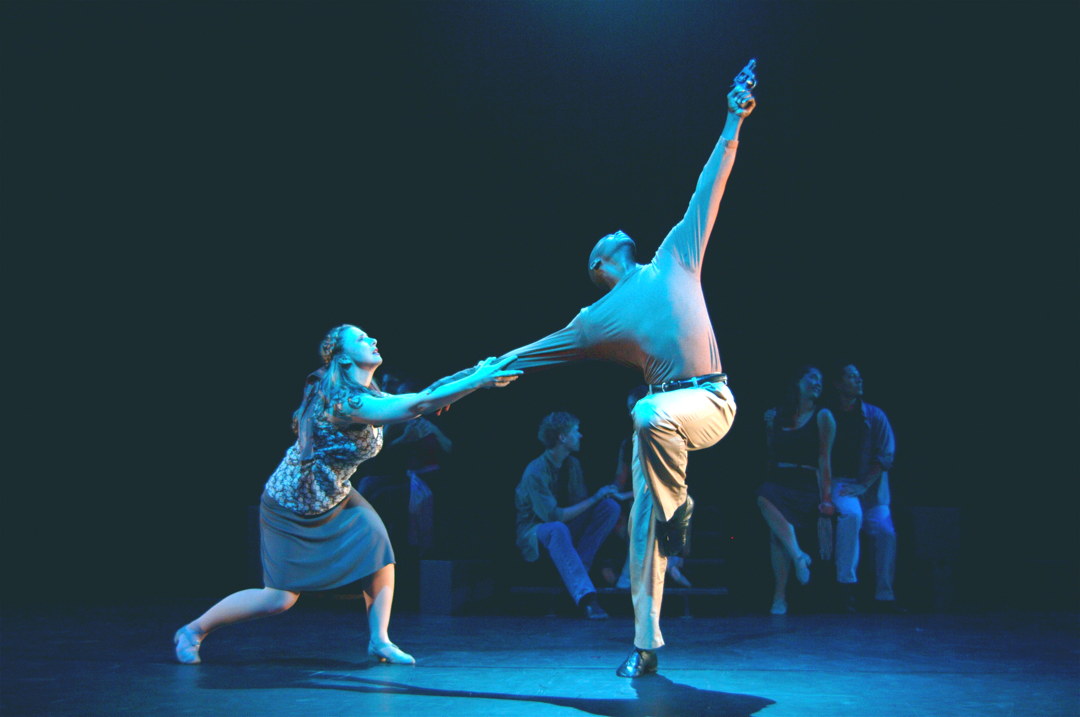 7. Empty sky… the Rising. Photo by courtesy of Bob Boross, photographer Eduardo Patino.
7. Empty sky… the Rising. Photo by courtesy of Bob Boross, photographer Eduardo Patino.
For years you have written articles about tap dance and jazz dance in famous magazines and lately you have collected them in a book called Comments on Jazz Dance 1996-2014. What are the aims behind the decision to publish your book?
«I had written individual articles that were published in many scholarly journals, trade magazines, and websites. But I never had a chance to see all of my written work together as whole. I approached publishers about this type of a project but without success. It is not hard to collate it all and then submit in book form to Amazon. Therefore you could call this book “self-published” (although each article had been individually published in other publications).
As to the value, nearly all of the articles cover people in jazz dance and aspects of jazz dance that have not been covered in other publications. It really is unique material. Like my articles about jazz dance teacher Michael Owens, my interview with Donald McKayle, also with Graciela Daniele, my review of Jack Cole’s personal scrapbooks, and even my article on the unique choreography strategies that I used in creating my Empty Sky…The Rising evening length dance piece».
Last but not least important, What are your plans for the future?
«Resources for dance production are hard to come by, and there is virtually no funding in an amount significant enough to make a full performance. I have a great store of impressive choreography that I still hope will be seen as in a full evening concert of my work.
I am not teaching a full schedule as I did in the past only because I’ve been dancing for 45 years now and my knees just can’t take the stress of multiple hours of teaching, five days a week. So I teach only a few classes a week in universities and at Broadway Dance Center in NYC. But of course everything now is taught on Zoom so I teach from my living room, which has been adapted into a dance studio. I do plan to continue teaching the Mattox freestyle method as I truly believe in it. And developing my Youtube jazz dance channel has been an interesting side project. But overall, I’d like to present my work whenever possible, and to maintain the health of my physical body despite many decades of intense, daily use.
And I hope to visit Italy more often, as my maternal relatives are from the town of Poggio Moiano near Rome, and I much enjoyed my past teaching engagements in Livorno and Castiglioncello. If any dance sponsoring organization would like me to come for choreography or some classes – please ask!».
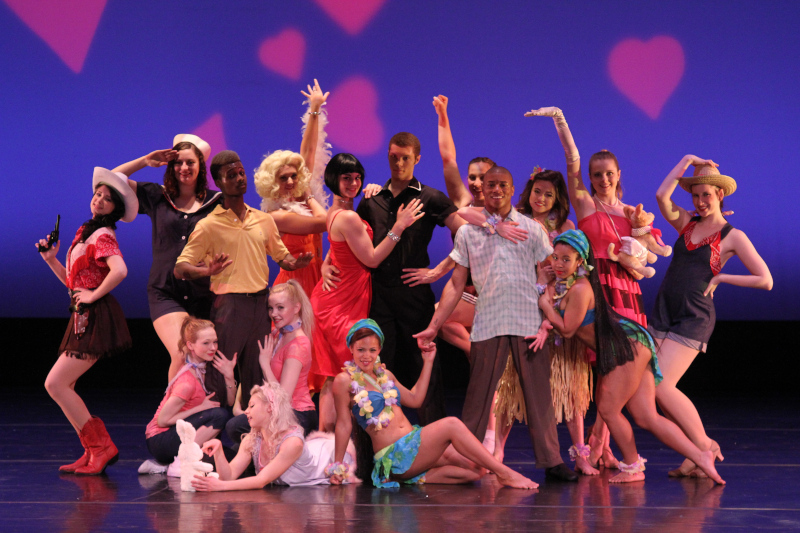 8. Love Fell Out With Me. Photo by courtesy of Bob Boross, photographer Rick Foster.
8. Love Fell Out With Me. Photo by courtesy of Bob Boross, photographer Rick Foster.
We thank Bob Boross for his time. For more information about his work, you can visit his official website and his Youtube channel.
Useful links: excerpt from Empty Sky… The Rising, videos of other concert dances here.
Leggi l’intervista in Italiano qui.
- Heather Cornell: la tap dance è musica, teatro e danza - 21 Gennaio 2024
- Heather Cornell: tap dance is music, theatre, and dance - 21 Gennaio 2024
- SETTE MUSICAL CINEMATOGRAFICI PER SETTE SERATE ESTIVE - 22 Agosto 2023


